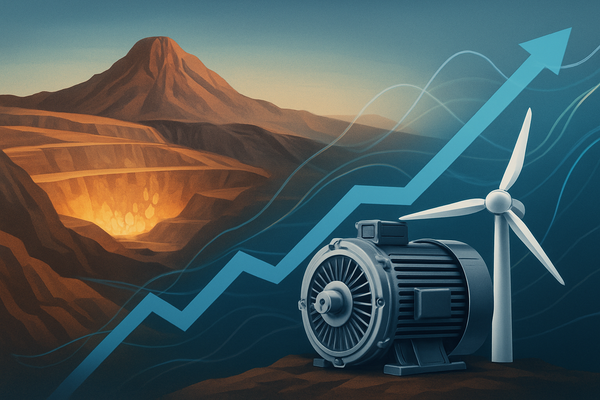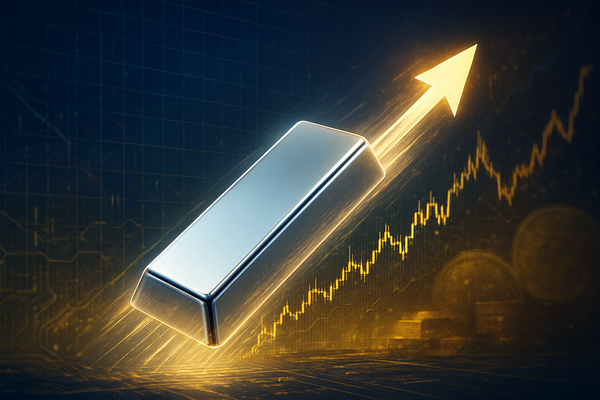Silver's Dual Dynamo: A Bullish Outlook Fueled by Safe-Haven Appeal and Surging Industrial Demand

Silver is currently presenting a compelling investment opportunity as of November 2025, with its dual identity as both a safe-haven precious metal and an indispensable industrial commodity driving robust market performance and a profoundly positive outlook. Recent market trends highlight significant price appreciation, persistent supply deficits, and surging demand from critical green technologies, collectively positioning silver for continued strength in the financial markets.
The metal's unique position, straddling both investment and industrial sectors, means its value is influenced by a complex interplay of macroeconomic factors, technological advancements, and geopolitical stability. This convergence has led to a remarkable rally throughout 2025, with silver outpacing gold and attracting substantial investor interest. The ongoing structural supply deficit further exacerbates this situation, as global mine production struggles to keep pace with an ever-increasing demand, leading to depleted inventories and a tight physical market.
Silver's Ascent: A Deep Dive into Market Dynamics and Drivers
Silver prices have experienced a remarkable rally throughout 2025, demonstrating an impressive surge that has captured the attention of investors worldwide. By early October, prices had already soared by 40-60% year-to-date, trading robustly around $46-$47 per ounce. This upward momentum culminated in silver reaching $53.99 USD per troy ounce on November 13, 2025, marking an astounding 77.78% increase compared to the same period last year. The metal even touched an all-time high of $54.49 in October 2025, a performance that has seen silver outpace gold, with a 61% year-on-year increase compared to gold's 57% year-to-date gain.
A critical factor underpinning this ascent is a structural supply deficit that has persisted for several consecutive years. Global mine production, estimated around 820 million ounces annually, is struggling to keep pace with total demand, which is projected to exceed 1.24 billion ounces in 2025. This significant gap represents the largest sustained deficit in over a decade. Consequently, above-ground inventories have been severely depleted, with registered silver stocks in COMEX warehouses declining by over 70% since their 2020 peak, signaling a very tight physical market. Key players in the mining sector, such as Fresnillo PLC (LSE: FRES) and Pan American Silver Corp. (NASDAQ: PAAS), have been grappling with these production constraints, while industrial giants like First Solar, Inc. (NASDAQ: FSLR) and major electronics manufacturers face increasing input costs.
The timeline of events leading up to this moment includes a confluence of factors. Growing global economic uncertainty, coupled with expectations of Federal Reserve interest rate cuts (with a high probability of a 25-basis-point cut in December 2025), has bolstered silver's traditional safe-haven appeal. Simultaneously, aggressive pushes towards renewable energy and electric vehicles have created an insatiable demand for silver in industrial applications. Initial market reactions have been overwhelmingly positive, with significant inflows into Exchange-Traded Products (ETPs) like the iShares Silver Trust (NYSEARCA: SLV), further tightening the physical supply by absorbing physical bars out of circulation. Central banks, including those of Russia, India, and notably Saudi Arabia, have also begun accumulating physical silver reserves, recognizing its value as monetary insurance and further validating its strategic asset status.
This dynamic environment underscores silver's unique position. Its ability to act as both a hedge against inflation and economic instability, while simultaneously being a critical component in the technologies driving the future, provides a robust foundation for its current and projected market strength.
Corporate Fortunes: Winners and Losers in the Silver Rush
The current bullish trend in silver prices and its dual demand drivers present a mixed bag of fortunes for public companies across various sectors. Mining companies, particularly those with significant silver operations, stand to be major beneficiaries, while industries heavily reliant on silver as an input material face increasing cost pressures.
Mining Companies: Riding the Wave Companies primarily engaged in silver mining are poised for substantial gains. Increased silver prices directly translate into higher revenues and improved profit margins, assuming production costs remain relatively stable.
- Fresnillo PLC (LSE: FRES), one of the world's largest primary silver producers, is a clear winner. Higher silver prices will significantly boost its profitability and potentially lead to increased shareholder returns.
- Pan American Silver Corp. (NASDAQ: PAAS) and Wheaton Precious Metals Corp. (NYSE: WPM), a precious metals streaming company, will also see enhanced financial performance. Streaming companies, which purchase a percentage of a mine's future production at a fixed price, benefit immensely when market prices for the underlying commodity rise significantly above their contracted rates.
- Smaller and mid-tier silver miners, often with higher operational leverage, could experience even more dramatic increases in their stock valuations as their projects become more economically viable and attractive to investors.
Industrial Users: Navigating Rising Input Costs Conversely, companies that rely heavily on silver for their manufacturing processes face the challenge of rising input costs. While demand for their end products (e.g., solar panels, EVs, electronics) remains strong, higher silver prices could compress profit margins or necessitate price increases for consumers.
- Solar Panel Manufacturers: Companies like First Solar, Inc. (NASDAQ: FSLR) and other global PV manufacturers are significant consumers of silver. While the solar industry is booming, the escalating cost of silver, a critical component in PV cells, will directly impact their cost of goods sold. This could spur further innovation in reducing silver content or finding alternative materials, but in the short term, it's a cost headwind.
- Electric Vehicle (EV) Manufacturers: Automakers such as Tesla, Inc. (NASDAQ: TSLA) and General Motors Company (NYSE: GM) are increasingly incorporating silver into their EVs, which use two to three times more silver than traditional internal combustion engine vehicles. While the overall cost of silver per EV is a small fraction of the total vehicle cost, a sustained rise could still add pressure to their supply chains and production budgets.
- Electronics and Semiconductor Companies: Giants like Intel Corporation (NASDAQ: INTC), Samsung Electronics Co., Ltd. (KRX: 005930), and Apple Inc. (NASDAQ: AAPL) use silver in various components, including semiconductors, printed circuit boards, and mobile devices. While their scale might allow for better negotiation, sustained high silver prices will inevitably factor into their manufacturing costs.
These dynamics create a fascinating landscape where investors must weigh the direct benefits to producers against the cost pressures on consumers. The ability of industrial users to innovate, secure supply, or pass on costs will determine their resilience in this evolving silver market.
Wider Significance: Silver's Role in a Shifting Global Economy
Silver's current market dynamics are not isolated but are deeply embedded within broader industry trends, reflecting significant shifts in global economic priorities and technological advancements. Its dual identity as a monetary metal and an industrial workhorse positions it at the nexus of several transformative movements.
The most prominent trend is the global push towards decarbonization and renewable energy. Silver is an indispensable component in photovoltaic (PV) solar panels, with the solar industry projected to consume over 232 million ounces in 2024 and potentially exceeding 300 million ounces annually by 2030. This makes silver critical for achieving climate goals, and its rising price could, paradoxically, accelerate innovation in silver-saving technologies within solar manufacturing. The rapid adoption of Electric Vehicles (EVs) further amplifies this trend; EVs utilize significantly more silver than traditional vehicles, tying silver's fate directly to the electrification of transportation. This sustained demand from green technologies ensures that silver is not merely a speculative asset but a foundational element of the future economy.
Regulatory and policy implications are also significant. Government incentives and mandates for renewable energy and EV adoption, such as those seen in the Inflation Reduction Act in the United States or the European Green Deal, indirectly bolster silver demand. Any shifts in these policies could have ripple effects on the industries that consume silver, thereby impacting its price. Furthermore, the increasing recognition of silver as a "strategic metal" vital for national technological and energy security could lead to policy discussions around supply chain resilience and domestic production.
Historically, silver has often been referred to as "poor man's gold," typically trailing gold's price movements but offering higher volatility. However, the current scenario, with industrial demand acting as a primary driver, differentiates it from past bull cycles primarily driven by monetary factors. A relevant historical precedent could be seen in the commodity supercycles of the early 2000s, where industrialization in emerging markets fueled demand for base metals. Today, it's the "green revolution" and digital transformation driving silver. The current supply deficit, the largest in over a decade, is reminiscent of periods where fundamental imbalances led to sustained price appreciation, forcing industries to adapt and innovate. This sustained deficit, coupled with central bank accumulation, indicates a structural shift rather than just a cyclical one, potentially leading to a re-evaluation of silver's intrinsic value and its role in the global financial system.
What Comes Next: Navigating Silver's Future Trajectory
The confluence of robust safe-haven demand and insatiable industrial consumption paints a compelling picture for silver's future, but also presents a landscape ripe with both opportunities and challenges. Understanding the short-term and long-term possibilities is crucial for investors and industries alike.
In the short-term (next 6-12 months), the bullish trend for silver is widely expected to persist. The immediate catalysts include continued global economic uncertainty, which will sustain safe-haven demand, and the anticipated Federal Reserve interest rate cuts in December 2025, which will reduce the opportunity cost of holding non-yielding assets like silver. Analysts anticipate silver to test the $50-$55 per ounce range, with some projections even targeting $57-$60 per ounce. However, investors should be prepared for potential short-term volatility. Given the relatively smaller size of the silver market compared to gold, corrections of 15-25% during bull market conditions are possible, and these could represent accumulation opportunities for long-term holders. Strategic pivots for industrial consumers might involve accelerating research into silver-saving technologies or exploring hedging strategies to mitigate price volatility.
Looking further into the long-term (1-3 years and beyond), silver's fundamental story remains exceptionally strong. The relentless demand from the solar energy sector, electric vehicles, 5G technology, and AI data centers is projected to continue growing, placing immense pressure on global supply. The structural supply deficit is unlikely to resolve quickly, as new mine discoveries and development are capital-intensive and time-consuming. This sustained imbalance suggests that silver prices could continue their upward trajectory, with some analysts targeting approximately $65 per ounce by 2026. Market opportunities will emerge for companies involved in silver recycling and refining, as the increasing value of silver makes reclamation more economically viable. Furthermore, investors may increasingly view silver as a strategic asset, providing exposure to both monetary debasement trends and the burgeoning clean energy and technology sectors. Potential scenarios include a "green premium" for silver, where its critical role in sustainable technologies drives its price beyond traditional precious metal valuations, or even a scenario where supply constraints become so severe that they impact the pace of green technology deployment.
Ultimately, the future trajectory of silver will depend on a delicate balance of macroeconomic policy, technological innovation, and geopolitical stability. Investors should closely monitor central bank actions, global economic health indicators, and advancements in industrial applications. For industries, adaptability and strategic sourcing will be key to navigating a market where a critical input material is becoming increasingly valuable and scarce.
Comprehensive Wrap-up: Silver's Enduring Significance
Silver's current market performance underscores its unique and increasingly critical role in the global economy. As of November 2025, the metal is demonstrating robust strength, driven by a powerful synergy between its traditional safe-haven appeal and an unprecedented surge in industrial demand, particularly from the burgeoning green energy and technology sectors. Key takeaways include the impressive price rally throughout 2025, with silver outpacing gold and reaching new highs, largely fueled by a persistent and significant structural supply deficit. This deficit, coupled with declining above-ground inventories, signals a fundamentally tight physical market.
Moving forward, the market appears poised for continued upward momentum. Expectations of Federal Reserve interest rate cuts and ongoing global economic uncertainties will sustain silver's allure as a hedge against inflation and instability. However, it is the insatiable demand from solar panels, electric vehicles, and advanced electronics that truly differentiates this bull market from previous cycles, positioning silver as an indispensable commodity for the future. Companies involved in silver mining stand to benefit significantly, while industrial users face the challenge of managing rising input costs, potentially driving innovation in silver-saving technologies.
The lasting impact of this period will likely be a re-evaluation of silver's strategic importance. It is no longer just "poor man's gold" but a critical component in the global transition to a sustainable and technologically advanced future. Investors should watch for continued central bank accumulation, further developments in green technology adoption, and any shifts in global monetary policy. While short-term volatility is always a possibility, the long-term fundamentals suggest that silver's dual dynamo will continue to power its ascent, making it a compelling asset to monitor in the coming months and years.
This content is intended for informational purposes only and is not financial advice



